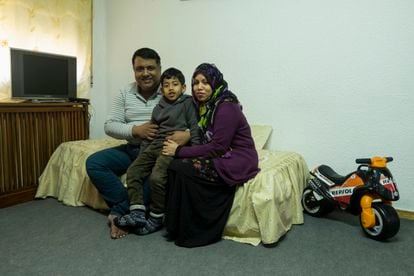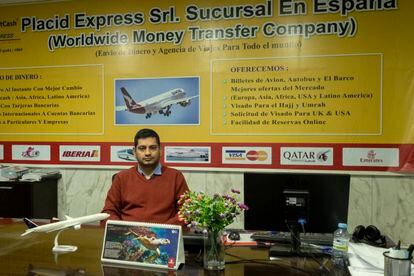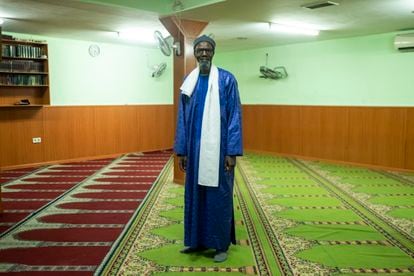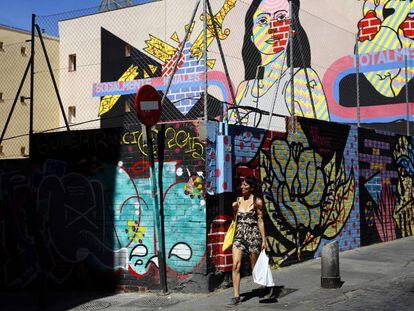How price hikes in Lavapiés are changing one of Madrid’s most popular ‘barrios’
The neighborhood is undergoing a gentifrication process, forcing out many Asian and African immigrants who have made their home here
/cloudfront-eu-central-1.images.arcpublishing.com/prisa/SRDLMUWSKZBSFHZUYWUMBO4L5Q.jpg)

As though he were the mayor of a small town, Elahi Mohammad Fazle knows almost all the Bangladeshis living in Lavapiés by name. Having himself lived in this multicultural neighborhood in the center of the capital for the past 15 years, Fazle, 41, has become a point of reference for his recently arrived compatriots. He hands them information on the paperwork they will need and courses in Spanish, and also organizes patriotic parties and talks to the local authorities about the problems and needs of the community. Last July, however, he had to leave the area as his rent was raised and he was unable to pay the new price. Taking their five-year-old son Tabib with them, he and his wife Tania Sultana moved to Usera, a more affordable area in the south of the city.
According to Fazle, the family had been paying €600 a month, but were recently told it was not enough. Their landlady clearly told him that she could make €2,500 by turning the property into a holiday rental. “How much can you give me?” she asked him.
It was as good as an eviction order. Earning just €900 a month as an information assistant in a social center run by the city council, Fazle couldn’t compete. And while he and his family have settled in Usera, other Bangladeshis are moving to Vallecas, Villaverde or wherever they can find cheap accommodation.

The same thing is also happening to Senegalese immigrants and other minorities who have settled in this central district, which is officially known as Embajadores, over the last 20 years. In dozens of interviews, people said that the rent hikes are shaking the very foundations of the area’s ethnic communities. Both those who arrived years back and those coming in now are finding themselves scattered across the city.
Like many others, Fazle feels a certain bitterness that he can no longer stay in the place he has come to consider home. “Lavapiés is my other girlfriend,” he says. “I’ve been in love with her since I arrived.”
He still spends 12 hours a day in the neighborhood, dividing his time between the Casino de la Reina Community Centre where he works and the Valiente Bangla headquarters on 14, Provisiones Street – the association he set up to help fellow Bangladeshis find their feet. And while some of those who have been driven out return here to shop and eat, like Fazle, many don’t come back, which means that small businesses serving their needs are struggling to survive.
“I don’t make the same sales as I used to,” says the 44-year-old Bangladeshi fruit seller Mohamed Shah Alam. “There are fewer people and there’s less business.” From his fruit shop in Plaza de Lavapiés he can see the other source of his troubles: a Carrefour Market that is open 24/7. It is one of two Carrefour stores in Spain that introduced the 24-hour schedule in 2015.
Even ethnic businesses serving clients across the board are watching their customer base dwindle. A month ago, the popular Senegalese restaurant Baobab closed down and the building next to Nelson Mandela Square was snapped up by an investor. And soon the Prinoy hostel will also close, the first port of call in Madrid for many Senegalese immigrants.
The last straw for the Senegalese community could be the closure of the Al Taqua mosque and Islamic studies center at 9, Cabestreros Street, where they pray in Wolof. As a buffer against rent hikes, Imam Demba Diagne started a collection a year ago to raise the €500,000 that they believe the 300-square-meter facility could cost them. But it is a mammoth effort as resources are scarce and they haven’t raised even a tenth of what they need. “People can’t give much – €20, €30 per person,” says Diagne, 58. “I want to be optimistic but it’s very difficult.”

On January 1 of this year, 2,980 Bangladeshis and 587 Senegalese citizens were registered in this neighborhood, which has a total population of 47,151. In 2010, there were 3,337 and 934 members of these communities living here, respectively. The drop from the 2010 peak is not dramatic and there has even been a slight upturn in the numbers of Bangladeshis in the last two years, but it is generally acknowledged that as landlords demand more for their properties, there will be an increasing dearth of people from these minorities.
The gentrification of Lavapiés has picked up pace in the past year, according to real estate agents, who say the 2018 riots put the brakes on it for a while. Investors are encouraged by the fact that tourists are replacing immigrants, says Victor Rodriguez, a consultant at Ficasa real estate. “I’ve been walking along the street with clients who pass immigrants and say, not here,” says Rodriguez, referring to those put off by the neighborhood demographics. Those who do buy a property aim to rent it either to tourists or to young bohemians from Spain and other parts of Europe.
According to numerous complaints, the immigrants leave not only because of their lack of purchasing power, but also because of the racism, with potential tenants facing something akin to a casting procedure. Landlords have been known to slam the door or hang up on immigrants wanting to rent from them.

“You can tell from the tone of their voice that they know you’re a foreigner and they are not going to give it to you,” says Omar Gala, a 50-year-old Senegalese cleaner who moved to Carabanchel a few months ago.
Shajid Mowla, a 38-year-old Bangladeshi looking for a new location for his money transfer business, had the offer of a rental property withdrawn 15 days after putting down a month’s deposit. They asked him for six months’ guarantee, which was not in the advertisement. Even whe he produced documents to show his company was solvent, it was of no use. “What can you do?” he says with resignation.
This kind of racism is very widespread. According to a 2017 survey carried out by the Ministry of Labor and Migration, only 53.4% of respondents would rent their homes to an immigrant. Real estate agents say this is partly due to a generalized fear among landlords that the tenant will start subletting and turn the property into what is known as a piso patera – an overcrowded apartment with 10 and more residents.

Many people in Lavapiés seem to accept this shifting character as inevitable – as just another era for a neighborhood accustomed to change. It was, after all, once filled with Spaniards from the provinces, and then there were the Chinese immigrants who came and went.
But the tourists don’t help build a community; they make too much noise and make the residents feel out of place. “When I go to work in the morning, I see more and more suitcases,” says Ana María Díaz, a 50-year-old who has grown up in the neighborhood.
Still, there is no shortage of young bohemian types looking to live in the area. This week, the Redpiso real estate agent Jorge Hoyas rented what the property platform Idealista has called “the cheapest apartment in Lavapiés” to a 24-year-old Galician musician, Rober Carlos. It’s a 25-square-meter, third-floor property with windows on the inner courtyard, and the asking price was €600 euros a month – a rare find, as one.bedroom apartments in Lavapiés usually go for upwards of €750.
Having seen the neighboring district of Malasaña undergo the same gentrification and influx of tourists, Hoyas believes that the process in Lavapiés can only gather momentum. “Something very similar is happening here,” he says. “This has two or three years left as it is.”
English version by Heather Galloway.











































